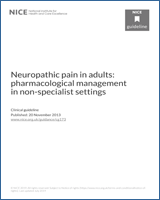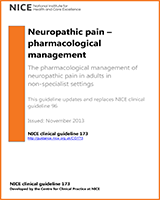NCBI Bookshelf. A service of the National Library of Medicine, National Institutes of Health.
Update information July 2019: Because of a risk of abuse and dependence, pregabalin and gabapentin are controlled under the Misuse of Drugs Act 1971 as class C substances and scheduled under the Misuse of Drugs Regulations 2001 as schedule 3 (as of 1 April 2019). Footnotes in this guideline have been updated to reflect this change. April 2018: Warnings have been added to link to the MHRA's latest advice and resources on sodium valproate. Sodium valproate must not be used in pregnancy, and only used in girls and women when there is no alternative and a pregnancy prevention plan is in place. This is because of the risk of malformations and developmental abnormalities in the baby. September 2020: As part of a surveillance review on neuropathic pain, the available evidence on treating sciatica was reviewed. As the NICE guideline on low back pain and sciatica already covered this topic area, it was agreed that the revised advice would be best placed in that guideline (see the section on pharmacological management of sciatica). Some research recommendations in this guideline that previously covered sciatia have been amended. See these changes in the short version of the guideline
Excerpt
This short clinical guideline aims to improve the care of adults with neuropathic pain by making evidence-based recommendations on the pharmacological management of neuropathic pain outside of specialist pain management services. A further aim is to ensure that people who require specialist assessment and interventions are referred appropriately and in a timely fashion to a specialist pain management service and/or other condition-specific services.
Contents
- Introduction
- Patient-centred care
- Strength of recommendations
- Update information
- 1. Recommendations
- 2. Development of the guideline
- 3. Evidence review and recommendations
- 4. References
- 5. Glossary and abbreviations
- 6. Other information
- Appendix A. Contributors and declarations of interests
- Appendix B. List of all research recommendations
- Appendix C. Guideline scope
- Appendix D. How this guideline was developed
- Appendix E. Evidence tables
- Appendix F. Full health economic report
- Appendix G. GRADE profiles and results for ‘all neuropathic pain’
- Appendix H. GRADE profiles and results for ‘peripheral neuropathic pain’
- Appendix I. GRADE profiles and results for ‘central neuropathic pain’
- Appendix J. GRADE profiles and results for individual adverse effects for ‘all neuropathic pain’
- Appendix K. Specimen WinBUGS code
- Appendix L. Validation of efficacy dataset used in health economic model
This guideline updates and replaces NICE clinical guideline 96
NICE clinical guidelines are recommendations about the treatment and care of people with specific diseases and conditions in the NHS in England and Wales.
This guidance represents the view of NICE, which was arrived at after careful consideration of the evidence available. Healthcare professionals are expected to take it fully into account when exercising their clinical judgement. However, the guidance does not override the individual responsibility of healthcare professionals to make decisions appropriate to the circumstances of the individual patient, in consultation with the patient and/or guardian or carer, and informed by the summary of product characteristics of any drugs.
Implementation of this guidance is the responsibility of local commissioners and/or providers. Commissioners and providers are reminded that it is their responsibility to implement the guidance, in their local context, in light of their duties to have due regard to the need to eliminate unlawful discrimination, advance equality of opportunity and foster good relations. Nothing in this guidance should be interpreted in a way that would be inconsistent with compliance with those duties.
- Review Neuropathic Pain: The Pharmacological Management of Neuropathic Pain in Adults in Non-Specialist Settings[ 2010]Review Neuropathic Pain: The Pharmacological Management of Neuropathic Pain in Adults in Non-Specialist SettingsCentre for Clinical Practice at NICE (UK). 2010 Mar
- Critical Care Network in the State of Qatar.[Qatar Med J. 2019]Critical Care Network in the State of Qatar.Hijjeh M, Al Shaikh L, Alinier G, Selwood D, Malmstrom F, Hassan IF. Qatar Med J. 2019; 2019(2):2. Epub 2019 Nov 7.
- Neuropathic pain: clinical features, assessment and treatment.[Nurs Stand. 2010]Neuropathic pain: clinical features, assessment and treatment.Fear C. Nurs Stand. 2010 Oct 13-19; 25(6):35-40.
- Review Neuropathic pain: a pathway for care developed by the British Pain Society.[Br J Anaesth. 2013]Review Neuropathic pain: a pathway for care developed by the British Pain Society.Smith BH, Lee J, Price C, Baranowski AP. Br J Anaesth. 2013 Jul; 111(1):73-9.
- Methylphenidate poisoning: an evidence-based consensus guideline for out-of-hospital management.[Clin Toxicol (Phila). 2007]Methylphenidate poisoning: an evidence-based consensus guideline for out-of-hospital management.Scharman EJ, Erdman AR, Cobaugh DJ, Olson KR, Woolf AD, Caravati EM, Chyka PA, Booze LL, Manoguerra AS, Nelson LS, et al. Clin Toxicol (Phila). 2007 Oct-Nov; 45(7):737-52.
- Neuropathic PainNeuropathic Pain
Your browsing activity is empty.
Activity recording is turned off.
See more...

